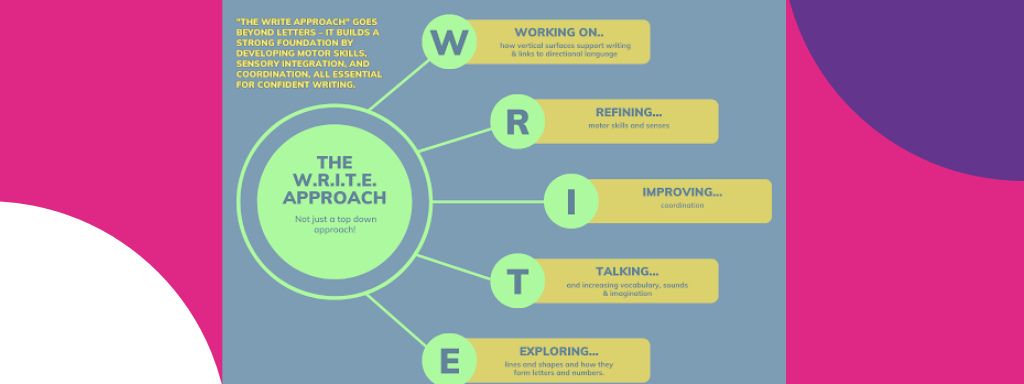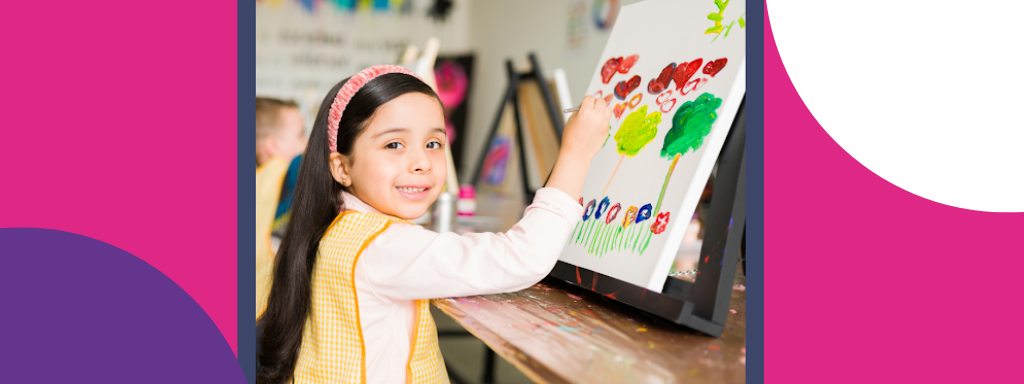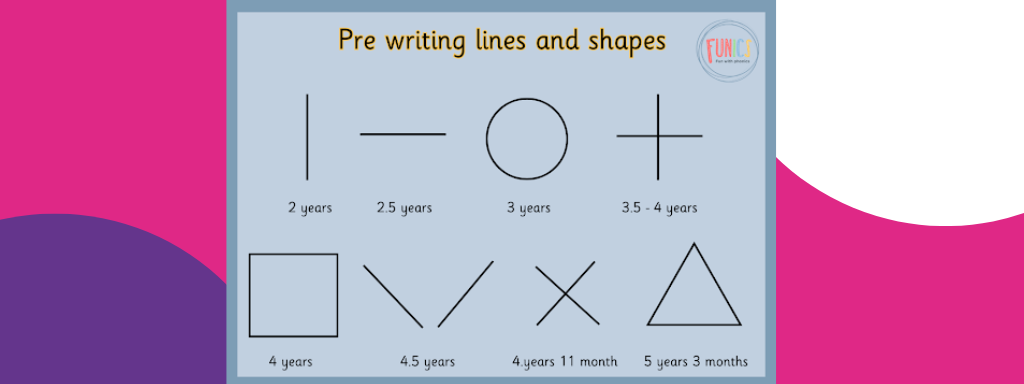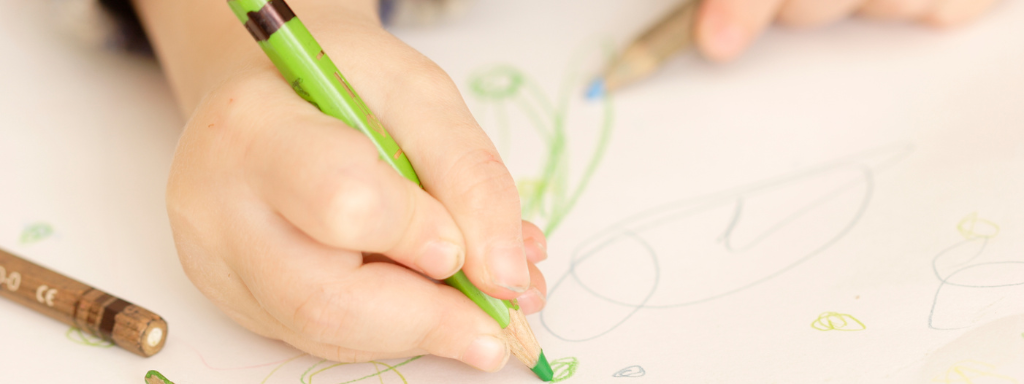What do you think pre-writing skills are and what activities can you do to encourage them? They may not be just what you think they are! We are joined by Rachael Hartless from Funics, read on to learn her tips!
Rachael is an early years teacher with over 30 years of experience. Over the years, many children go to school struggling to write. And this seems to be increasing year on year. Read on to find some tips to help you support your little one.
The W.R.I.T.E. Approach
I recently developed the W.R.I.T.E. approach to help children and their adults to work on the skills that are often missed or not worked on enough and that are crucial and foundational to writing.

Let’s look at why each area in the W.R.I.T.E. approach is so important.
W = Working On Vertical Surfaces
Working on a vertical surface encourages children to stand more which supports their core muscles and is a more physical approach. It supports the shoulder and wrist extension and is especially good for children who may be left-handed. It also helps with hand and eye coordination and visual tracking.

R = Refining Motor Skills
Refining motor skills and senses are vital to be able to control and manipulate a pencil with the correct pressure to ensure hands don’t fatigue, and writing is legible. The senses I’m talking about are not as well known as the other 5 senses but are majorly important.
Vestibular is the sense of balance and body awareness during writing activities. Things like swinging and rocking help develop the vestibular system, improving posture control for comfortable writing. Children innately know this, which is why they’re often upside down hanging off sofas!
I = Improving Coordination
Improving coordination of the body and motor skills is vital for prewriting readiness. Children develop muscles from the core out to help with stamina. To be able to control their hand muscles they must first be able to control their core muscles to stay upright, and have stable shoulders and strong arms. They must be able to track lines and shapes accurately and improve their sense of spatial awareness to help judge distances, sizes, and orientations of letters and shapes accurately.
Coordination also includes engaging in activities that involve crossing the midline, such as drawing shapes that extend from one side of the body to the other, promoting integration of both sides of the brain which is necessary for writing and reading across the whole page. Using 2 hands together is bilateral coordination and activities like using scissors to cut shapes or manipulating playdough with both hands at the same time strengthen the connection between the brain’s hemispheres and improves hand-eye coordination. For writing one hand secures the paper and one hand writes.
T = Talking And Vocabulary Development
If a child can’t say it they are unlikely to write it. They will also write it as they say it so be aware of family words or how “cute” they pronounce some words. My daughter used to say “rubely” instead of rugby. It sounded cute but if we hadn’t corrected this she would have written “rubely”.
It’s not just reading to a child, it’s talking to them about what you are doing and answering their questions.

E = Exploring Lines And Shapes
Now this is often missed in favour of getting straight onto writing letters. But working on these lines and shapes will allow your child to learn about direction, orientation, refine precise hand movements, spatial relationship, size, controlling the direction and flow of their writing.
Every letter and number is made from these shapes and as you can see a ‘x’ is developmentally about 4 years 11 months which is why your toddler may add a ‘+’ as a kiss on cards instead of a ‘x’.

How To Keep The W.R.I.T.E. Method In Mind
Let’s look at some ideas for each of the letters in W.R.I.T.E. so that your child gets a firm foundation in the pre-writing skills needed for writing at school.
Vertical surfaces
Use an easel, chalkboard, outside wall with chalk/water, bath, paper on wall at head height or even a window. Encourage them to reach up high and make the marks big to start with. Start off drawing freely then encourage the lines appropriate for their age/development. Get them to start at the top, on the left and in an anticlockwise direction depending on the shape.
Motor skills and senses
Sensory resources such as sand, water, rice, beans, play dough, clay, and fingerpaints as all the tactile activities help children to refine their motor skills, and strengthen their fingers. Pouring, scooping and digging using two hands will help children receive feedback from their muscles and joints helping them adjust how much pressure or force is needed.
Coordination
Playing in parks, an obstacle course that encourages children to go over, under, through or climb. Catching games to help with hand and eye coordination, sorting, and threading pasta onto pipe cleaners. Play hopscotch (masking tape inside if wet) and Simon Says or Follow The Leader to support imitation and coordination. Use masking tape inside to make tracks to walk along and do puzzles.
Talking and vocabulary
Talk, talk and talk some more to your child.
Hearing words on TV or through an audiobook is ok, but it means children don’t get that two-way conversation and any misconceptions corrected. Sing lots of rhymes and if they are finger rhymes even better as then your child is also working on moving their fingers independently which again supports writing.
When sharing a book, point out things and name them, ask questions, encourage them to describe things or make guesses about them. Join in imaginative play, making animal noises, taking on a character role and encourage conversation.

Lines and shapes
Use cutters and dough to make shapes and talk about the lines, stick small stickers along a line, trace over lines and shapes with a paintbrush and water large scale at first. Use finger paints and vehicles in paint to make marks. Find objects such as a fence panel to “start at the top and go all the way down” with water to work on the vertical lines. When helping to cook, get them stirring in an anticlockwise direction. Later begin to scale down to paper and crayons then tracing over lines.
Children need to do something correctly about 40-50 times before it just begins to make muscle memory. Muscle memory is important to form lines and shapes and therefore letters without thinking too much about it. By the time they start in year 1 they need to be thinking more about what to write rather than how to write.
Thanks To Rachael, Co-Founder Of Funics
If you do nothing else before your child starts school then work on these areas. Your child does not need to know how to write their name or form letters but if they have the skills above they will quickly transfer them to writing at school.
I’m Rachael, a teacher and co-founder of Funics. At Funics our mission is to support grownups in empowering children with not only the foundation skills they need at school but a love for
learning. Our activities are designed to foster a love of literacy from the start. We also strive to ensure children say sounds and form letters correctly from the start. I’m also an Early Years Teacher currently working in an outstanding school.
My co-founder Helen and I have taught many children over the years who have struggled at school because they must unlearn poor habits. We run local in-person classes, training, and a subscription box packed with teacher videos and the resources needed to do each activity. Find out more about Funics on our website, Facebook, Instagram or Tiktok.
Want To Get Out And About, Have Fun With Your Baby Or Toddler, And Meet Other Parents?
Search Happity to find everything that’s happening for the under-5’s in your local area – from music and singing classes, to messy play, arts and crafts, baby massage, gymnastics and more. Simply enter your postcode and child’s age to search, and then book your spot in a few taps. Enjoy dedicated fun time with your little one, watch their skills develop, and make friends at the same time. Mums, dads, grandparents and carers will all find something to love!
If You Found This Post Useful, You May Also Like:
11 Easy Tips For Getting Your Children Involved In the Kitchen



0 Comments